Hairy Curtain Crust
A rather impressive looking crust, often forming dense clusters of annual fruit bodies on various hardwoods. The dominant colour is yellow to rusty orange, there is no sign of red on its hairy skin.
| Mushroom Type | |
| Common Names | Hairy Curtain Crust (EN), Hairy Parchment (US), Crawen Flewog (CY), Skórnik Szorstki (PL), Borostás Réteggomba (HU) |
| Scientific Name | Stereum hirsutum |
| Synonyms | Thelephora hirsuta |
| Season Start | All Year |
| Season End | All Year |
| Average Mushroom height (CM) | |
| Average Cap width (CM) | 3–10 |
Fruiting Body
This species might form fully resupinate, semi-pileate or pileate fruit bodies. Often grows in clusters, also often forms large tiers (when numerous fruit bodies are fused/overlapping).
3–10 cm long x 1–3 cm wide, semi circular to fan-shaped, and attaching to the substrate without having a stem.
Upper surface (skin) is covered with short, stiff hairs (hirsute). It is concentrically zoned. Originally ochre to yellow, but can be brownish too. Margin is sharp, yellow, but it might fade with age.
Fertile surface is smooth (or warty), bright yellow to brownish orange, fading to somewhat ochraceous with age.
Habitat
On the living and dead wood of hardwoods, and according to some authors, even on conifers, but we have never seen it on conifers. Saprotrophic, causes white-rot.
Possible Confusion
Other Stereum species look rather similar, and it often requires microscopy to separate them with confidence.
Hairy Curtain Crust is probably more commonly confused with Yellowing Curtain Crust (Stereum subtomentosum), pictured, and Bleeding Oak Crust (Stereum gausapatum).
Yellowing Curtain Crust has a pale greyish orange to whitish margin, and its greyish yellowish fertile surface stains yellow when cut or bruised.
Bleeding Oak Crust has white margin, and its buff to greyish brown fertile surface might turn dark red when cut or bruised.
Taste / Smell
Inedible. Taste and smell not distinctive.
Frequency
Very common and widespread in the UK.
Spores
Spore print is white. Spores ellipsoid, cylindrical, smooth, colourless (hyaline) and very slightly amyloid (which proves the spore wall does contain starch in traces).
Other Facts
Hairy Curtain Crust (Stereum hirsutum) is the type species of genus Stereum, but some authors suggest it is rather a species complex than just a single species.
The epithet (2nd part of the scientific name) refers to its hairy upper surface (skin) hence it means: covered with stiff hairs.
Stereum hirsutum can be parasited by a mycoparasitic species, called Naematelia aurantia, syn: Tremella aurantia, which is commonly called as Golden Ear in the US. Naematelia aurantia is a close relatives of Naematelia aurantialba, syn: Tremella aurantialba, the “real” Golden Ear and it is considered an edible and medicinal mushroom in China, and cultivated in large quantities. The story behind this confusion of common names is quite simple. N. aurantialba is only native to China, while N. aurantia has a much broader distribution, it is native to Europe, North & South America, Asia (incl. China) and Australia. Both species parasiting the mycelium of Hairy Curtain Crust, and the two species had been separated only in 1990 (until this point both were known as Golden Ear).
A rather fresh news that the EU recently gave permission to import Naematelia aurantialba to the EU. We have no information if it will have any effects on its availability to the UK.


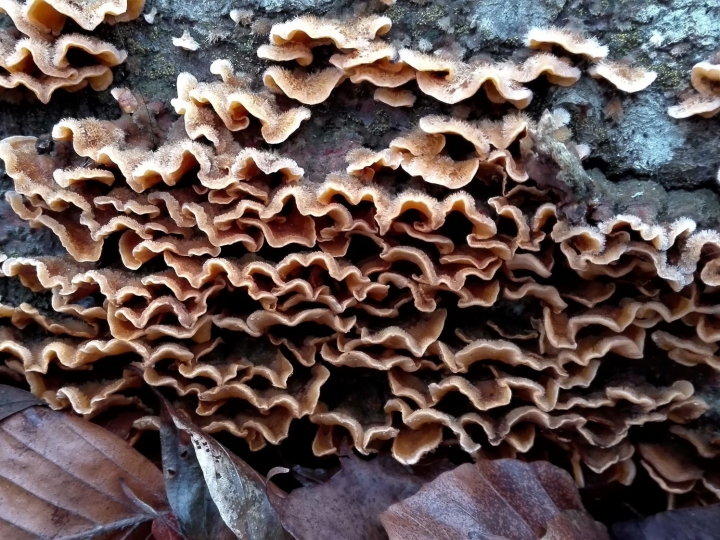
















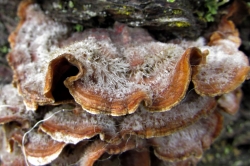
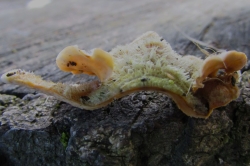
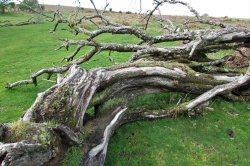
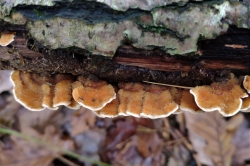





COMMENTS